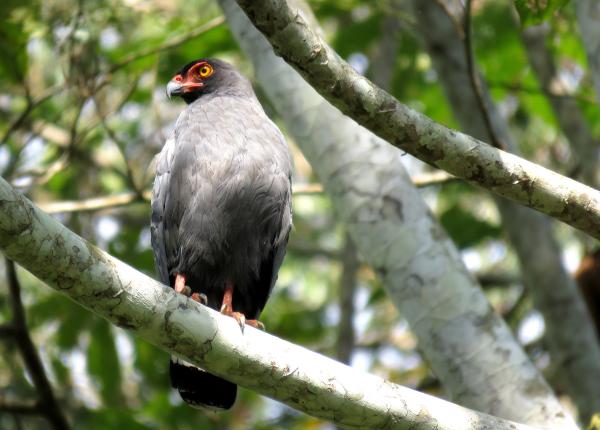Did You Know?
- Though it might be surprising to hear, there isn't any information at all about the breeding biology or ecology of the Slate-colored Hawk!
- This hawk doesn't soar very often, if ever.
How The Peregrine Fund is Helping
Though The Peregrine Fund does not work directly with Slate-colored Hawk, our efforts in scientific research, habitat conservation, education, and community development help conserve birds of prey around the world. We also supply literature to researchers from our avian research library, which helps scientists around the world gather and share important information on raptor conservation. Our work with the Neotropical Raptor Network helps conserve raptors by fostering collaboration and communication among raptor enthusiasts in the region. And, finally, our support of the Global Raptor Information Network gives raptor researchers tools to more efficiently conduct their own studies while contributing to a global program. It also provides citizen scientists a way to participate in raptor science and conservation.
Where They Live
This Neotropical species is found in the Amazonia region of South America, in parts of Colombia, Venezuela, Ecuador, Peru, Bolivia, French Guiana and Brazil. A lowland species is can be found frequenting the shady banks of rivers and lakes, flooded backwaters, mangroves, swamps, as well as tropical forests and wetlands.
What They Do
As its name implies, the Slate-colored Hawk is mostly slate gray overall. However it has a striking reddish cere, yellow eyes, and red legs. This hawk has been described as "sluggish" and doesn't soar, if ever. It is a diurnal, non-migratory bird of prey.
Why They Need Our Help
This hawk is categorized as a species of Least Concern by BirdLife International. This means conservationists believe this hawk's population will remain stable into the foreseeable future. However, deforestation throughout its range will likely have a detrimental effect on the species in the future.
What They Eat
This stunning hawks has quite a varied diet. It hunts snakes, lizards, frogs, crabs, fish, and even insects. In order to capture its prey, this hawk very often sits in wait on relatively low, exposed branches along streams. When it observes something it would like to eat, it drops on its prey. Similar to the Double-toothed Kite, it is also known to follow monkey troops to capture insects flushed up by the monkeys as they move through the forest canopy.
Slate-colored Hawk and the World Center for Birds of Prey
Though the World Center for Birds of Prey is located far away from Slate-colored Hawk habitat, it is a great place to visit to learn about birds of prey of all kinds. There are informative exhibits, touch-tables, videos, and even live bird presentations on hand! Our staff and volunteers are also present to help answer any questions you may have about Slate-colored Hawks or any other raptors. Additionally, a local species of hawk, the Red-tailed Hawks, is quite common around The Peregrine Fund's World Center for Birds of Prey – watch for them as you drive up to the entrance as they are often perched on fence posts or soaring low over the grassy fields on either side of the road. When walking our nature trail, be sure to look for them soaring high in the sky. An interpretive sign at the end of the trail teaches you how to identify a raptor based on its silhouette.
References:
Bierregaard, R. O., P. F. D. Boesman, and J. S. Marks (2020). Slate-colored Hawk (Buteogallus schistaceus), version 1.0. In Birds of the World (J. del Hoyo, A. Elliott, J. Sargatal, D. A. Christie, and E. de Juana, Editors). Cornell Lab of Ornithology, Ithaca, NY, USA. https://doi.org/10.2173/bow.slchaw2.01
Global Raptor Information Network. 2021. Species account: Slate-colored Hawk Buteogallus schistaceus. Downloaded from http://www.globalraptors.org on 30 Nov. 2021









